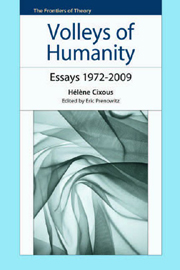Book contents
- Frontmatter
- Contents
- Sources
- Series Editor's Preface
- Introduction: Cixousian Gambols
- 1 Fiction and Its Phantoms: A Reading of Freud's Das Unheimliche (The ‘Uncanny’)
- 2 The Character of ‘Character’
- 3 Missexuality: Where Come I Play?
- 4 The Pleasure Reinciple or Paradox Lost
- 5 Reaching the Point of Wheat, or A Portrait of the Artist as a Maturing Woman
- 6 Letter to Zohra Drif
- 7 The Names of Oran
- 8 The Book as One of Its Own Characters
- 9 How Not to Speak of Algeria
- 10 The Oklahoma Nature Theater Is Recruiting
- 11 The Book I Don't Write
- 12 The Unforeseeable
- 13 Passion Michel Foucault
- 14 Promised Cities
- 15 Volleys of Humanity
- Acknowledgements
- Index
4 - The Pleasure Reinciple or Paradox Lost
Published online by Cambridge University Press: 12 September 2012
- Frontmatter
- Contents
- Sources
- Series Editor's Preface
- Introduction: Cixousian Gambols
- 1 Fiction and Its Phantoms: A Reading of Freud's Das Unheimliche (The ‘Uncanny’)
- 2 The Character of ‘Character’
- 3 Missexuality: Where Come I Play?
- 4 The Pleasure Reinciple or Paradox Lost
- 5 Reaching the Point of Wheat, or A Portrait of the Artist as a Maturing Woman
- 6 Letter to Zohra Drif
- 7 The Names of Oran
- 8 The Book as One of Its Own Characters
- 9 How Not to Speak of Algeria
- 10 The Oklahoma Nature Theater Is Recruiting
- 11 The Book I Don't Write
- 12 The Unforeseeable
- 13 Passion Michel Foucault
- 14 Promised Cities
- 15 Volleys of Humanity
- Acknowledgements
- Index
Summary
If, among the billions of motifs that ‘adomically’ [cf. FW 615.6] constitute Finnegans Wake, I simply could not help [m'empêcher] picking out [pêcher] the ‘Phoenix’, it is because this motif appears at the beginning of the Portrait of the Artist, where it is surreptitiously associated with the theme of Sin [Péché].
The Portrait of the Artist recounts the genesis of the artist Stephen Dedalus. It begins somewhat like this: ‘Once upon a time there was a strange little birdie …’ This strange bird, a tuckoo (a cuckoo badly pronounced, that is), will grow into Dedalus, the flying artist, a strange bird indeed. All this begins thus like a strange f/airy tale [conte de fée/ nix]. This tale lays its first egg – a little scene, two pages long. These two pages contain, in embryonic form, the totality of James Joyce's work, including Finnegans Wake. The Portrait opens with a primitive scene, a fateful [destinale] scene in which the one who will become the artist is put to the test of the Law. The origin of this primitive scene is always the same, namely the first, Eve's primitive scene/sin [(s)cène] in the very first book which deals with the question of whether or not to be in the know [faire ou pas la connaissance de la connaissance]. There is the Apple; there is the secret of the Apple.
- Type
- Chapter
- Information
- Volleys of HumanityEssays 1972–2009, pp. 75 - 84Publisher: Edinburgh University PressPrint publication year: 2011



